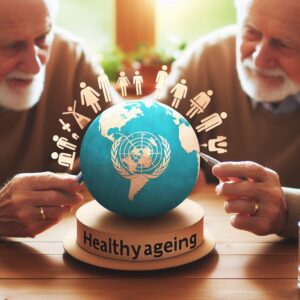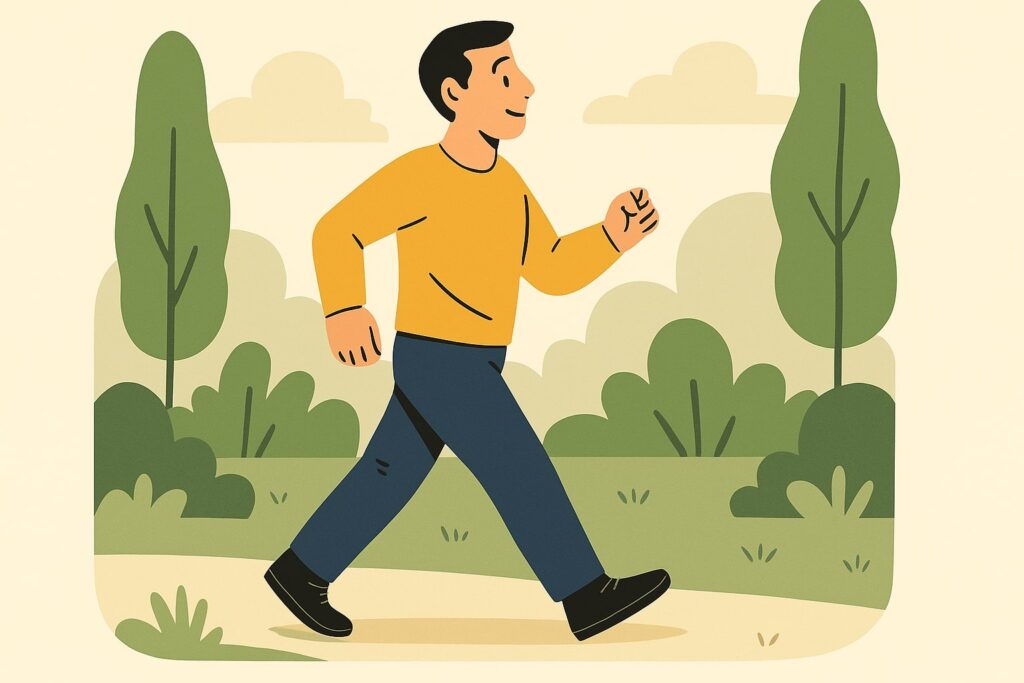The elderly population of the world is rapidly increasing: Demographically, global populations are aging at a swifter pace than seen in the past, and this transition will impact nearly all facets of society. The COVID-19 pandemic has revealed the weaknesses in policies, systems, and services: This crisis has emphasized the severity of existing deficiencies in policies, systems, and services that affect the health and well-being of older individuals, particularly in low- and middle-income nations.
Numerous older individuals confront obstacles and barriers: Many senior citizens lack access to the fundamental resources necessary for a purposeful and dignified life. Additionally, many others face challenges that hinder their full participation in society. Hence, a decade of united efforts for Healthy Aging is imperative to ensure that older people can achieve their potential with dignity and equality in a healthy environment.
Index of Contents
ToggleWhy is it important to promote healthy ageing globally?

Fostering vigorous maturation on a global scale holds immense significance. This not only enhances the vitality and quality of life in older people but also empowers them to participate and contribute to society actively in meaningful ways. Moreover, it alleviates the strain and expenses of healthcare and social systems while bolstering nations’ economic growth and advancement. In addition, achieving the 2030 Agenda for Sustainable Development is inextricably linked to promoting healthy aging by the aspiration to leave no one behind and safeguard the human rights of all individuals at any age.
Healthy aging rests not only on individual well-being but is also a shared responsibility that warrants coordinated efforts and actions from all sectors and stakeholders. We can ensure that everyone ages gracefully and equitably by cultivating age-appropriate environments and opportunities.
some challenges of promoting healthy ageing globally
The impacts of population aging: A novel predicament confronts the world – a future where the elderly population surpasses the number of children and the extreme old age demographic reaches unprecedented levels. This shift will inevitably affect every facet of society, from healthcare and social security to labor markets and intergenerational relations.
Inequities in health and the role of social determinants: Among older individuals, significant differences in health and well-being are observed, both within and across nations. Many factors, including income, education, gender, ethnicity, and access to health and social services, influence these discrepancies. An effective public health response must address these disparities and the underlying social determinants of health.
The impact of chronic diseases and geriatric syndromes: As individuals age, they are more susceptible to developing multiple chronic conditions, such as diabetes, heart disease, and dementia, as well as complex health states like frailty, falls, and incontinence. These conditions necessitate integrated and person-centered care, often lacking in current healthcare systems.
Underinvestment in prevention and promotion: Globally, there is a concerning lack of investment in prevention and promotion efforts for age-related diseases and disabilities. For instance, on average, European countries allocate only 2.8 percent of their healthcare budget towards preventive measures. Prevention and promotion strategies can be crucial in helping older individuals maintain their functional ability, independence, and overall quality of life.
The absence of data and research: There is a pressing need for improved data and research on the health and well-being of older individuals, particularly in low- and middle-income countries where the majority of the elderly population reside. Robust data and research can aid in monitoring and comprehending the trends and patterns of aging, identifying the most effective and cost-effective interventions, and informing policies and programs.
Inadequate infrastructure and institutions: Many nations, such as age-friendly environments and long-term care facilities, need more vital infrastructure and institutions to support healthy ageing.
Importance to promote older people’s rights and contributions
The significance of older people’s rights and contributions cannot be overstated. It serves as a manifestation of honoring their dignity and promoting equality as fellow human beings, ensuring that they are not subjected to discrimination based on age.
Moreover, it acknowledges the uniqueness and potential of this group, valuing their vast life experiences, knowledge, and expertise in various spheres of existence.
It empowers them to actively engage and meaningfully participate in the social, economic, cultural, and political realms, granting them a voice and the autonomy to make decisions that directly impact them.
Ultimately, recognizing and upholding their rights leads to the betterment and advancement of their families, communities, and societies, contributing to realizing the 2030 Agenda for the Sustainable Development Goals.
Role of technology in promoting healthy ageing
In the promotion of healthy aging, technology plays a crucial role in aiding older adults in multiple facets of their lives, including:
1. Communication and Socialization: Technology allows older adults to stay connected with their loved ones and community, diminishing feelings of social isolation and loneliness. For instance, an easily accessible computer system enables email, video calls, and social media to facilitate communication with others.
2. Emergency Assistance and Security: Technology brings peace of mind and safety to older adults by alerting caregivers or emergency services in case of falls, injuries, or health emergencies. For example, a pedometer wristband monitors the activity and location of older adults. It sets off an alarm if they remain motionless for an extended period or wander outside a designated area.
3. Physical and Mental Well-being: Technology aids in maintaining and improving physical and cognitive health among older adults, delaying or preventing the onset of chronic diseases and disabilities. A neurofeedback headband, for instance, trains older adults to regulate their brainwaves, resulting in improved attention, memory, and mood.
4. Access to Healthcare and Self-Management: Technology allows older adults to access healthcare services remotely and self-manage their health conditions and medication. A biofeedback device is an example of technology that measures vital signs like blood pressure, heart rate, and oxygen saturation and transmits the data to healthcare providers or caregivers.
Moreover, technology supports caregivers and lessens the strain on healthcare systems by providing them with information, guidance, and tools to care for older adults more effectively and efficiently. However, for technology to truly cater to older adults and caregivers, it must be accessible, affordable, user-friendly, and practical, addressing their needs, preferences, and values while respecting their rights, dignity, and diversity. It must also empower and encourage their active participation.
some examples of healthy ageing:
Maintaining an active lifestyle and regularly exercising: Physical activity and exercise can preserve or enhance seniors’ strength, balance, flexibility, endurance, and cardiovascular health. They also act as a preventive measure, postponing the onset of chronic ailments like diabetes, heart disease, and stroke while reducing the risk of falls, fractures, and disabilities.
Additionally, physical activity and exercise positively affect mental health, cognitive function, and mood. Seniors can incorporate various forms of exercise into their routines, such as walking, cycling, swimming, dancing, gardening, tai chi, yoga, and resistance training.
Fostering a balanced, nutrient-rich diet: Consuming foods that provide ample energy, protein, vitamins, minerals, and antioxidants is essential for older adults to maintain a robust immune system, healthy bones, muscle mass, and skin integrity. It also serves as a preventative measure for chronic illnesses, including obesity, diabetes, hypertension, and osteoporosis, while decreasing the likelihood of malnutrition, anemia, and infections. Older adults should consider including various foods, such as fruits, vegetables, whole grains, lean meats, low-fat dairy, nuts, seeds, and fish.
Engaging in social and cognitive activities: Socializing and participating in mental activities can promote social connections with family, friends, and the community, ultimately reducing feelings of loneliness and social isolation. Such activities also stimulate the brain, improving memory, attention, reasoning, and creativity, slowing down cognitive decline and decreasing the likelihood of developing dementia or depression.
Reading, writing, playing games or puzzles, learning new skills and hobbies, volunteering, joining clubs, groups, or classes, and attending cultural or religious events are all excellent examples of social and cognitive activities in which seniors can participate.
Healthy aging does not solely revolve around avoiding disease or disability but also encompasses maintaining a good quality of life and being able to engage in activities that bring joy and fulfillment. Older adults can cultivate and maintain a healthy lifestyle by implementing the abovementioned practices.
some common health problems in older adults
Arthritis engenders joint inflammation and pain, affecting 49.7% of individuals over 65.
Heart disease: This affliction impacts the cardiovascular system, with a morbid result. In 2014, it took the lives of 489,722 senior citizens.
Cancer: This group of disorders entails irregular cell growth, spreading to other body regions. In 2014, it snuffed out 413,885 lives among older adults as the second leading cause of death.
Chronic obstructive pulmonary disease (COPD): This respiratory ailment impairs breathing, resulting in coughing, breathing difficulties, and chest constriction among 11% of older adults.
Alzheimer’s disease and dementia: These neural disorders cause memory loss and hinder problem-solving capabilities, affecting almost 12% of the elderly population.
These are among the most prevalent chronic conditions in older individuals, yet numerous other ailments can impact their well-being. It is imperative to regularly consult with a physician and adhere to their preventive or management guidance.
some examples of age discrimination:
The mistreatment of individuals based on their age, mainly if they are either older or younger than the norm, is dubbed as age discrimination. Some common manifestations of this type of discrimination are:
– Refusing to hire or promote someone solely because of their age. This occurs when employers favor younger or older workers for specific positions, disregarding qualified candidates based on age. For instance, an employer might assume that a younger worker is more innovative or adaptable or that an older worker is more experienced or reliable without considering their merits.
– Coercing an individual to retire or resign on account of their age. This is often the case when employers wish to dispose of older workers they perceive as less productive, more expensive, or more susceptible to health concerns. For example, an employer may pressure a more senior employee to retire by proposing a severance package, reducing their workload or responsibilities, or creating a hostile working environment.
– Denying benefits or opportunities to individuals based on their age. This occurs when employers discriminate against older or younger workers regarding pay, training, career development, or recognition. For instance, an employer might pay a younger worker less than an older worker for performing the same job or deprive a more senior worker of professional development opportunities or career advancement opportunities.
– Making derogatory remarks or jests about someone’s age. This commonly occurs when employers or colleagues harass, bully, or stereotype either older or younger workers based on their age. For example, an employer or colleague may ridicule a more senior worker’s appearance, memory, or abilities or resort to name-calling such as “grandpa” or “dinosaur.” Alternatively, they might mock a younger worker’s maturity, knowledge, or authority or call them “kid” or “rookie.”
Age discrimination is unlawful in numerous countries and has pervasive negative consequences on the well-being, performance, and motivation of employees.
Conclusion:
We hope you found our blog post on the United Nations Decade of Healthy Ageing informative and thought-provoking. The ageing population is a global issue that requires immediate attention and action. As we enter a new decade, it is crucial to prioritize the well-being of older people, their families, and their communities. By addressing the challenges they face, such as limited access to healthcare and social protection, we can work towards creating a more inclusive and equitable society for all age groups. Let us come together and support this initiative to ensure a healthier and happier future for older individuals worldwide. Together, we can make a difference.



